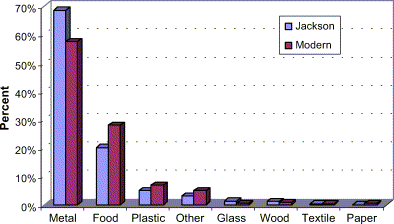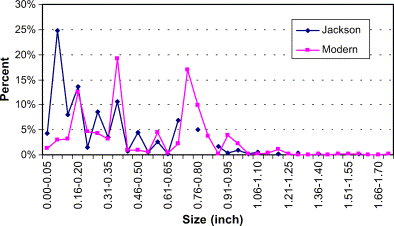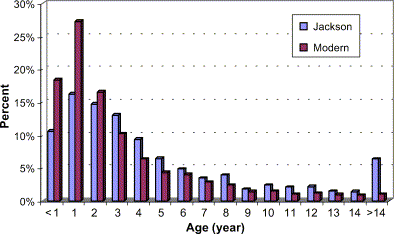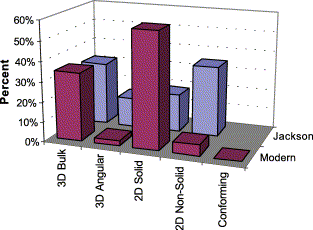bRAM Consulting Services, Oakbrook, IL, USA
cUniversity of Colorado, School of Medicine, Denver, CO, USA
dAI Dupont Hospital for Children, 1600 Rockland Road, Wilmington, DE 19803, USA
Abstract
Objective: To compare two databases of foreign body (FB) objects causing injury in children (<20 years of age) and record differences in size, shape and material for children at risk over a 70-year period of time. Study design: Retrospective analysis of the Jackson collection (JC) of FBs (1920–1932) and a 12-year Modern Study (MS) of data taken from 25 children's hospitals in North America over the period 1988–2000. Digital images were obtained of the JC Collection. Methods: Identify age, sex, and type of products, size, shape, and consistency of material from the injury-producing FBs. Statistical Processing for Social Sciences (SPSS) was used for analysis of JC vs. MS. Results: 5528 children were evaluated from the MS, and compared with 1238 from the JC. Boys remain at greater risk than young girls (53% vs. 47%) over the 70-year period of study. Coins have replaced safety pins (31% vs. 15%) as the most common offending FBs. Although 99% of FBs causing injury are less than 1.25 in. in greatest diameter in both the JC and MS, 100% of FBs are eliminated when the test size is greater than 1.75 in. Conclusions: Boys remain at greater risk of injury over the last 60 years. However, coins have now emerged as the leading cause of injury in children. Children achieve greater protection from risk by modification of the Small Parts Test Fixture (SPTF) from 1.25 to 1.75 in. diameter.
E-mail address: [email protected]
Popular choices
- Casinos Not On Gamstop
- Casinos Not On Gamstop
- UK Betting Sites
- UK Online Casinos Not On Gamstop
- UK Online Casinos Not On Gamstop
- Non Gamstop Casinos UK
- Slots Not On Gamstop
- Sites Not On Gamstop
- UK Casino Not On Gamstop
- Non Gamstop Casinos
- UK Online Casinos Not On Gamstop
- UK Online Casinos Not On Gamstop
- UK Online Casinos Not On Gamstop
- Casinos Not On Gamstop
- Top UK Slot Sites
- Casinos Not On Gamstop
- Non Gamstop Casino Sites UK
- Sites Not On Gamstop
- Casino Sites UK Not On Gamstop
- Casinos Not On Gamstop
doi:10.1016/S0531-5131(03)01118-X
Click here for the PDF version
Contents
1. Introduction
Chevalier Jackson retrieved over 3000 objects (foreign body=FB) from injured children in the first half of the 20th century, and this collection remains available for study. Jackson's detailed writings about FBs served as the basis for the creation of standards for the Small Parts Test Fixture (SPTF) within the United States [1, 2, 3].
Recent analysis of FBs that caused injuries to over 5500 children in the last decade strongly suggested that FB injuries follow patterns of predictable injury. Both size and distinct shapes of FBs increase the risks of more severe injury, especially asphyxiation, for young children [4, 5, 6, 7, 8].
We have undertaken the task to measure the Jackson collection (JC) of FBs and to compare our Modern Study (MS) to determine what trends of FB injuries and their subsequent care have changed over the past 70 years in North America. The JC collection has been digitally photographed for preservation and future analysis.
2. Materials and methods
The Mutter Museum of the Philadelphia College of Physicians houses the archived collection of Chevalier Jackson, the pioneer and esteemed endoscopist of the twentieth century in the United States. Jackson and colleagues removed a total of 32,000 objects between 1920 and 1932. The materials included in this collection are meticulously itemized, and large portions are available for study (JC). All objects that remain intact and available for measurement were included (N=1307).
Twenty-five children's hospitals and tertiary care paediatric facilities located over the North American Continent participated in a retrospective analysis of injury from aspirated and ingested FBs, for children less than 20 years of age. This database covered the period 1988–2000. A total of 5528 FB events are recorded in this Modern Study (MS) database.
All data were recorded for age, sex, type of injury, site of injury, and clinical and diagnostic findings. Patients in the MS study were identified by ICD-9 and CPT codes. All JC FBs were obtained or identified from the Mutter collection or pictures from within the Jackson textbook [10]. All objects were measured directly with a digital electronic calliper (PDC-150). The two databases (MS and JC) were compared for this study. Data were then analysed using Statistical Processing for Social Sciences (SPSS version 7.5.2). Graphs were obtained by exporting the data to Microsoft Excel.
3. Results
The MS contained 5528 FB episodes in children. The six most common FBs in the JC were food (21%), safety pins (15%), Nails (13%), coins (10%), and buttons (7%). Coins (47%) dominate in the MS followed by food (28%), jewellery (5%), nails (3%) and toys (3%) (Table 1).
| Description | Jackson study (1920–1932) | Description | Modern study (1988–2000) |
|---|---|---|---|
| (1) Food | 21% (276) | (1) Coins | 47% (2612) |
| (2) Safety pin | 15% (191) | (2) Food | 28% (1565) |
| (3) Nails | 13% (169) | (3) Jewelry | 5% (251) |
| (4) Coins | 10% (135) | (4) Nails | 3% (155) |
| (5) Buttons | 7% (89) | (5) Toys | 3% (138) |
| (6) Jewelry | 6% (82) | (6) Pens | 1% (80) |
| (7) Toys | 5% (63) | (7) Plastic | 1% (74) |
| (8) Teeth | 2% (26) | (8) Teeth | <1% (52) |
| (9) Discs | 2% (24) | (9) Buttons | <1% (49) |
Size and shape were recorded when the FBs could be measured. Food objects were measured only when intact. In the MS (n=2044), 100% of all objects were 1.75 in. or less, and 99.1% measured less than 1.25 in. The objects in the JC (n=1047) of the study were slightly smaller, with all measurable FBs 1.60 in. or less. Again, 99.5% were within the present 1.25-in. SPTF standard (Fig. 1).
The average age of injury in the MS was 24 months (2 years). The study of the JC identified 1301 FB events in children with the average age for treatment as 38 months (3.2 years) (P<0.05). The MS was made up of 53% males and 47% females. The percentage distribution of males and females was recorded in Jackson's original report in 1917, and gives identical distributions (53% boys and 47% girls) [10] (Fig. 2).
The materials (MS) most commonly identified were metal (58%) and food (28%). The materials (JC) most commonly identified were metal (69%) and food (20%). Synthetic material (plastic) was present in the MS at 7%, but plastic was lower in JC (5%). Glass, textiles, paper and wood were found at 1% (Fig. 3).

Shapes were compared, and follow similar patterns; three-dimensional with bulk (3D Bulk) was the most commonly found (32% vs. 35%). Two-dimensional solid objects (e.g. coins) replaced two-dimensional non-solid objects (e.g. safety pins) in frequency (58% vs. 35%) (Fig. 4).
4. Discussion
This study demonstrates a significant variation in exposure risks to young children over the past century. The average age for injury is now considerably younger for the MS (25 vs. 36 months). Boys remain at greater risk than young girls. Common injuries from household objects such as safety pins, tacks and needles have been eliminated.
Variance between the two may be explained based upon several factors. The JS reflected a practice that was over 40% referral from other surgeons and may have biased the sample to FBs that exceeded the skill of other specialists, and anaesthesia for procedures was less available for young children 70 years ago.
The MS also shows that larger FBs may cause injury and potential risks for aspiration and asphyxiation. Approximately 99% of FBs are less than 1.25 in. in diameter. The Small Parts Test Fixture (SPTF) is a codified standard of a truncated cylinder, which has a diameter of 1.25 in. at the top (simulating the mouth) and a variable depth to the cylinder of 1.50–2.25 in. (representing the pharynx) [3]. The SPTF, the best known and most widely used standard for the United States, was developed in the 1970s and was based upon concepts and data originally collected 50 years earlier by Chevalier Jackson.
Present standards for FBs intended for use by young children (less than 3 years of age) are based upon analysis of the JC injuries and are outdated. When the data from the late twentieth century MS and JC data are analysed, elimination of risk can better approach 100% only if stricter criteria are applied. All FBs analysed for ingestion or aspiration injury are eliminated if a standard of 1.75-in. diameter is applied [5]. This newer information is particularly effective when applied to spherical objects that are known to be most dangerous and can result in a variety of newer interventions for parents, physicians and product suppliers [6].
Application of this newer standard is voluntary and has not yet been codified for products intended for young children under any age. Avoidance of specific items, which present a higher potential for injury for the "at risk" population, must be initiated [9]. Reports on paediatric injury detail FBs, which are particularly dangerous for young and vulnerable children and include solid objects such as balls, and foods, e.g. hot dogs [10, 11]. Strategies for successful interventions from public and private health care providers are based upon principles of avoidance, caretaker vigilance and pre-emptive design strategies to achieve Six Sigma Safety [12].
5. Conclusion
Over the past century, FBs continue to cause injury and remain a hazard for young children, particularly young boys. Metal objects, particularly coins, are now the most frequent injury-producing FBs. This change reflects a dramatic change in the risks within the environment of children, along with the elimination of safety pins, needles and tacks.
Analysis of the size and shape of FBs causing injury reaffirms that the Small Parts Test Fixture, which was developed and based largely upon data from the Jackson collection, should be replaced for added safety. A greater margin of safety is obtained if a 1.75-in. test apparatus is used and weighted (2 lb) for spherical objects.




